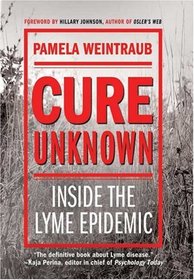The title proclaims "Cure Unknown" in large, alarming and eye-catching type against a bleak gray cover, and Weintraub's book proves to be as sensational as the title and cover suggest. Such sensation makes science writing appealing and readable, but in this case it detracts more than it adds. Weintraub has many positive, reasonable points to make, but her immediate descent into hyperbole overshadows most of those points.
Certainly Lyme is a common disease in the rural and suburban New England; however "One cannot inhabit the northeastern suburbs without seeing the damage- children with headaches that never go away, forty year olds with limps, teenagers too fatigued to study or engage fully in the activities of life." (pg 210) is certainly an overstatement. Lyme disease, when left untreated, can be debilitating and painful. But the majority of cases are treated, even if only as a precautionary measure, and no lasting effects occur. Doctors are most definitely fallible human beings, but they are not systematically denying the existence of a disease. The tests for Lyme are not always the first test performed, but they are (to date) tricky and inconclusive, often providing both false positives and false negatives. This last is more a result of the limit of modern science, not a conscious denial of a disease by the medical establishment as a whole.
Reading the accounts of Weintraub's own experiences with Lyme and those of her interviewees is heart-wrenching; but it is not the rule, it is the exception. If her book spurs any increase in interest and support for Lyme research than it has certainly had a positive effect. Lyme is a problem. It is one that is being diligently researched and monitored by doctors and public health officials. WebMD lists at least 50 antibiotics that are used to treat Lyme disease; there is a Lyme vaccine available; none of these facts justify the exaggeration of such a title or attitude as Weintraub displays.
Certainly Lyme is a common disease in the rural and suburban New England; however "One cannot inhabit the northeastern suburbs without seeing the damage- children with headaches that never go away, forty year olds with limps, teenagers too fatigued to study or engage fully in the activities of life." (pg 210) is certainly an overstatement. Lyme disease, when left untreated, can be debilitating and painful. But the majority of cases are treated, even if only as a precautionary measure, and no lasting effects occur. Doctors are most definitely fallible human beings, but they are not systematically denying the existence of a disease. The tests for Lyme are not always the first test performed, but they are (to date) tricky and inconclusive, often providing both false positives and false negatives. This last is more a result of the limit of modern science, not a conscious denial of a disease by the medical establishment as a whole.
Reading the accounts of Weintraub's own experiences with Lyme and those of her interviewees is heart-wrenching; but it is not the rule, it is the exception. If her book spurs any increase in interest and support for Lyme research than it has certainly had a positive effect. Lyme is a problem. It is one that is being diligently researched and monitored by doctors and public health officials. WebMD lists at least 50 antibiotics that are used to treat Lyme disease; there is a Lyme vaccine available; none of these facts justify the exaggeration of such a title or attitude as Weintraub displays.




